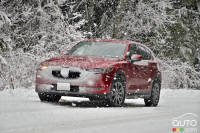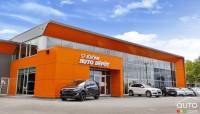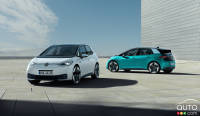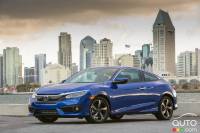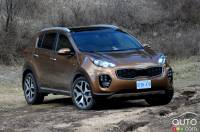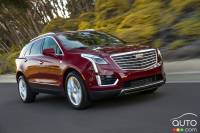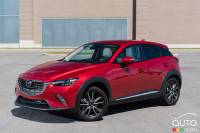Mercedes continues its assault on the North American diesel market, which started back in 2006. The German automaker is launching a trio of new SUVs powered by the world's cleanest state-of-the-art diesel engine.
The R320 BlueTEC, ML320 BlueTEC and GL320 BlueTEC all use the same V6 powerplant with Mercedes' BlueTEC system. The latter includes AdBlue injection, a technology that has been in place in Mercedes trucks and buses for a number of years. Thusly powered, these three new SUVs produce less greenhouse gas emissions; in fact, they meet the stringent Bin 5 standards applicable in North America. That will make things much more interesting at Mercedes dealerships starting this fall.
Power and efficiency
The 3.0-liter diesel engine has undeniable potential, starting with 210 horsepower and a remarkable 398 lb-ft of torque from as low as 1,600 rpm, which makes for excellent towing capacity. It also promises outstanding fuel economy and ultra-low CO2 emissions, making the GL320 BlueTEC the most fuel-efficient full-size SUV in Canada.
Technology
First introduced with the E320 BlueTEC sedan, the six-cylinder diesel engine had to be modified in order to power the BlueTEC SUVs. The piston crowns were revised for an improved mixture formation, and the compression ratio was reduced from 17.7 to 16.5. The VNT turbocharger and engine control unit were also improved and reconfigured. All three of the new SUVs are available only with the 7G-TRONIC seven-speed automatic transmission.
Nitrogen oxides dramatically reduced
The most important goal for Mercedes when developing the BlueTec powerplant was to achieve a drastic reduction in nitrogen oxide emissions, the only exhaust gas constituent which has inherently higher levels in diesel engines than in gasoline engines. Engineers therefore combined an oxidizing catalytic converter and a particulate filter with AdBlue to eliminate nitrogen oxides.
AdBlue injection
AdBlue is an aqueous urea-based mix that is injected into the stream of exhaust gases and carried in a 28- to 32-liter auxiliary tank, depending on the vehicle. When injected into the hot, pre-treated exhaust gases, AdBlue is first broken down into water and urea. From around 170 degrees Celsius, the urea is converted into ammonia, which is then stored inside the catalytic converter to reduce nitrogen oxides. The average amount of AdBlue required for this process is only about 0.1 liter per 100 kilometers.
Extensive equipment
The R320 BlueTEC, ML320 BlueTEC and GL320 BlueTEC also come with an extensive list of features: Bluetooth connectivity, auxiliary input jack, SIRIUS satellite radio, Harmon Kardon premium audio and much more. Occupants will enjoy great peace of mind thanks to a host of advanced safety systems. Competitors will go green... with envy.
photo:Mercedes-Benz
The R320 BlueTEC, ML320 BlueTEC and GL320 BlueTEC all use the same V6 powerplant with Mercedes' BlueTEC system. The latter includes AdBlue injection, a technology that has been in place in Mercedes trucks and buses for a number of years. Thusly powered, these three new SUVs produce less greenhouse gas emissions; in fact, they meet the stringent Bin 5 standards applicable in North America. That will make things much more interesting at Mercedes dealerships starting this fall.
 |
Power and efficiency
The 3.0-liter diesel engine has undeniable potential, starting with 210 horsepower and a remarkable 398 lb-ft of torque from as low as 1,600 rpm, which makes for excellent towing capacity. It also promises outstanding fuel economy and ultra-low CO2 emissions, making the GL320 BlueTEC the most fuel-efficient full-size SUV in Canada.
Technology
First introduced with the E320 BlueTEC sedan, the six-cylinder diesel engine had to be modified in order to power the BlueTEC SUVs. The piston crowns were revised for an improved mixture formation, and the compression ratio was reduced from 17.7 to 16.5. The VNT turbocharger and engine control unit were also improved and reconfigured. All three of the new SUVs are available only with the 7G-TRONIC seven-speed automatic transmission.
Nitrogen oxides dramatically reduced
The most important goal for Mercedes when developing the BlueTec powerplant was to achieve a drastic reduction in nitrogen oxide emissions, the only exhaust gas constituent which has inherently higher levels in diesel engines than in gasoline engines. Engineers therefore combined an oxidizing catalytic converter and a particulate filter with AdBlue to eliminate nitrogen oxides.
AdBlue injection
AdBlue is an aqueous urea-based mix that is injected into the stream of exhaust gases and carried in a 28- to 32-liter auxiliary tank, depending on the vehicle. When injected into the hot, pre-treated exhaust gases, AdBlue is first broken down into water and urea. From around 170 degrees Celsius, the urea is converted into ammonia, which is then stored inside the catalytic converter to reduce nitrogen oxides. The average amount of AdBlue required for this process is only about 0.1 liter per 100 kilometers.
Extensive equipment
The R320 BlueTEC, ML320 BlueTEC and GL320 BlueTEC also come with an extensive list of features: Bluetooth connectivity, auxiliary input jack, SIRIUS satellite radio, Harmon Kardon premium audio and much more. Occupants will enjoy great peace of mind thanks to a host of advanced safety systems. Competitors will go green... with envy.
photo:Mercedes-Benz






